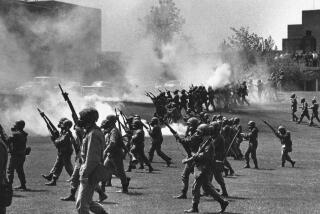Why they kill
- Share via
MASS MURDER certainly wasn’t invented with the 1966 Texas Tower shootings. For as long as there has been history, there has been murder -- including horrific mass murder. Certainly in the first half of the 20th century there were examples, such as the case of Howard Unruh, a mentally ill war veteran who killed 13 people in 13 minutes with a Luger pistol on the streets of Camden, N.J., in 1949.
But 1966 was a dramatic turning point. On Aug. 1, Charles Whitman, a student at the University of Texas at Austin, climbed up a 27-story tower and killed 14 people, wounding 31 others, before being shot dead by the police.
After the Whitman killings, the incidents started to climb. Mass murders (and, especially, mass shootings) became increasingly common -- George Hennard in Killeen, Texas; Patrick Edward Purdy in Stockton; James Huberty in San Ysidro; Eric Harris and Dylan Klebold at Columbine High School in Littleton, Colo., to name just a few -- and the body counts began to grow as well. Seven of the eight largest mass shootings in modern U.S. history have occurred in the last 25 years.
The murder of at least 32 people at Virginia Tech on Monday may have been the worst, but it was only one of about 20 mass shootings that occur each year in the United States (a subset of the two dozen or so mass murders). A mass murder is defined as an event in which four or more people are killed in the same episode. Serial killings, by contrast, occur over an extended time.
What accounts for the increase? Is it possible that man (and yes, 95% of all mass murderers are men, who tend to be far more comfortable and better trained in using firearms) has simply grown more evil and bloodthirsty since 1966 than during the previous millenniums of human existence?
Of course not. But several changes have taken place that have made such incidents more common.
One, of course, is the change in the potency of weaponry. Before 1966, the best weapons available to most would-be killers were pistols, rifles, maybe a shotgun. That is no longer the case; today, semiautomatics are all too easily accessible.
But there also have been societal changes that have increased the incidence of mass killing. In studying mass murderers over 25 years, my colleague, Jack Levin, and I have identified five factors that exist in virtually all cases.
First, perpetrators have a long history of frustration and failure and a diminished ability to cope with life’s disappointments.
Second, they externalize blame, frequently complaining that others didn’t give them a chance. Sometimes they argue that their ethnic or racial group or gender isn’t getting the breaks that others are. (An example of this is Marc Lepine, who killed 14 female engineering students at the Ecole Polytechnique of the University of Montreal, apparently because he felt that women were taking too many seats at the university.)
Third, these killers generally lack emotional support from friends or family. You’ve read the “he always seemed to be something of a loner” quote? It has a grounding in reality.
Fourth, they generally suffer a precipitating event they view as catastrophic. This is most often some sort of major disappointment: the loss of a job or the breakup of a relationship. In massacres at colleges and universities, it’s often about getting a grade the shooter feels he didn’t deserve. In 1991, a graduate student at the University of Iowa killed five people because he thought his physics dissertation should have won a prestigious $1,000 award.
Fifth, they need access to a weapon powerful enough to satisfy their need for revenge.
So what has changed? For one thing, the United States has become much more dog-eat-dog, more competitive in recent years. We admire those who achieve at any cost, and it seems that we have less compassion for those who fail. (Just look at how eager we are to vote people off the island or to reject them in singing competitions.) This certainly increases frustration on the part of losers.
Then there’s the eclipse of traditional community: higher rates of divorce, the decline of church-going and the fact that more people live in urban areas, where they may not even know their neighbors. If mass murderers are isolated people who lack support, these trends only exacerbate the situation.
Many mass murderers, for example, are people who have picked up roots and moved. James Huberty, who used a 9-mm semiautomatic Uzi to kill 21 people during a 77-minute massacre at a McDonald’s in San Ysidro in 1984, had moved to California from Ohio after losing his job. When he lost another job in California, he had no friends or extended family to fall back on. They were all in Ohio.
These days, we know an awful lot about why these events occur. We’re beginning to understand the motivations behind events that, to many people, seem senseless. But that doesn’t mean we can prevent them. We’re not going to build fortresses out of our college campuses, nor should we.
It should give us some degree of consolation to know that these events are exceedingly rare. But they still occur, and they are among the sad and tragic prices we pay for the kind of open, modern, democratic society we live in.
More to Read
Sign up for Essential California
The most important California stories and recommendations in your inbox every morning.
You may occasionally receive promotional content from the Los Angeles Times.










